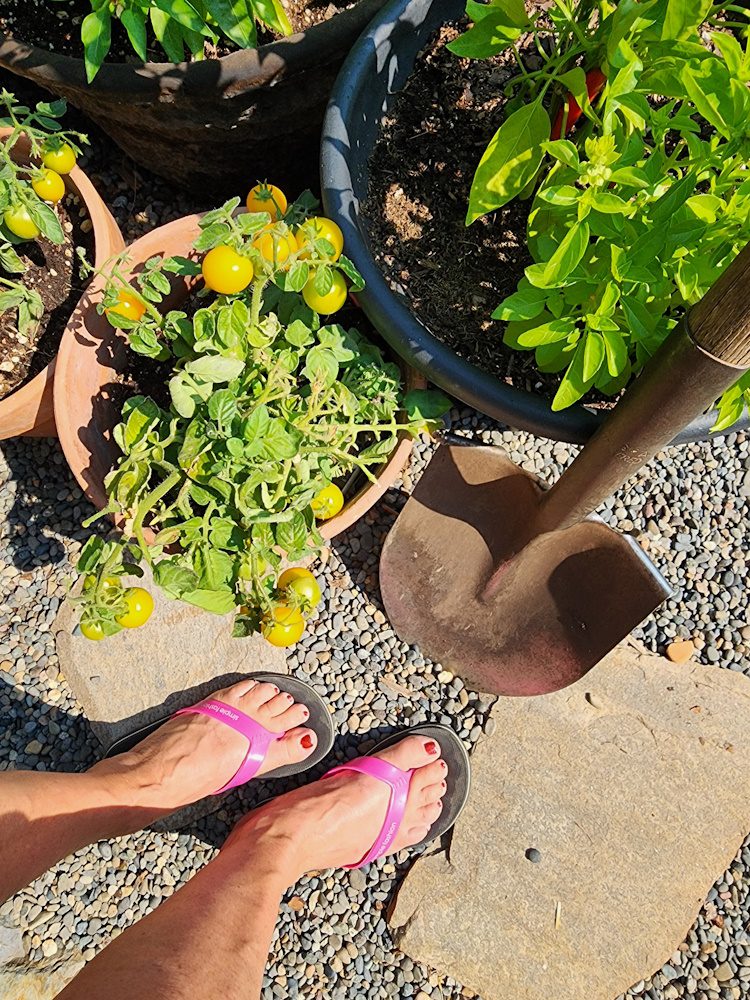They say every rose has its thorn, and ouch! They’re not joking! The garden may look like paradise, but it can hide a few hazards among those roses. If you’re a gardener, you’ve probably experienced a few scratches, strains, and stings along the way.
Gardening is a great way to relax and enjoy nature, but it can be tough on your body—kneeling and bending to plant and harvest, lifting and hauling bags of soil, and dragging hoses. Whew! Then add in the tools—rusty and dull—and don’t forget the buzzing, biting, and stinging creatures of nature.
Thankfully, adopting a few smart habits can help you avoid injuries, keep your tools in optimal condition, and make your garden a more enjoyable place to spend time.
Safety Starts with You
Dress the Part. Keeping yourself safe in the garden starts with dressing for success, from head to toe: no power suits and pearls here, but essentials like a hat, gloves, and sturdy shoes.
A wide-brimmed hat, sunscreen, and a lightweight long-sleeved shirt can protect you from sunburn and heat exhaustion. You can find shirts with UV protection built in or try garden “sleeves” that slide over your arms.
Garden gloves are essential and your first line of defense against cuts, splinters, fungal infections, and soil-borne diseases. Select high-quality gloves that are sturdy, comfortable, and fit well.
Trust me, I understand how tempting it is to garden in flip-flops, but your toes will thank you for wearing closed-toe shoes to prevent stubbed toes (how many pedicures have I ruined?).

Mind Your Body Mechanics. Gardening is a workout—sometimes an intense one—and just like at the gym, you need to pay attention to how your body moves. With that in mind, doing a little warm-up before getting down to weeding can help prevent aches and pains later.
Lift bags of soil using your knees, not your back. Break up tasks to avoid repetitive strain injuries: dig for a while, then take a break, or alternate between tasks and motions. A kneeling pad or stool can protect your knees and back during long gardening sessions. Look for tools with ergonomic handles to reduce muscle fatigue.

Of course, if you ever feel overheated or lightheaded, it’s time to go inside and hydrate. Most importantly, pace yourself and enjoy the process.
Be(e) Aware of Living Hazards. Bees, wasps, and many other flying and crawling critters call your garden home. While most stings are harmless, some can be dangerous. Give critters their space and trap or remove any that are truly dangerous or unwanted.

Also, be aware of which plants in your garden are toxic to humans and pets. Some plants, like foxglove and lilies, are poisonous, so be sure to keep pets and kids away and wash your hands after touching their foliage. It’s a good idea to keep the phone number for poison control handy and have a small first aid kit nearby for those unavoidable rose-thorn pricks.
Tools and Equipment Safety
Keep Tools Sharp and Clean. There’s something to be said about being the sharpest tool in the shed. While sharp tools can be intimidating, it’s the dull ones that hurt you. Sharp pruners, shovels, and trowels make work easier and reduce stress on your muscles – that’s where accidents happen.

In addition to keeping tools sharp, regularly wipe down pruners, shears, and shovels to prevent rust and, most importantly, to stop the spread of plant diseases.
Handle with Care. Always cut away from yourself, not toward. Power tools require extra caution—read those instructions (yes, really), wear eye protection, and unplug or remove batteries when not in use.
A garden rake lying on the ground might seem like a cartoon gag until it smacks you in the forehead (which really hurts). Store tools on hooks, in a shed, or in a secure bin. Another trip hazard is hoses. When not in use, coil them or use a hose reel. Be mindful of drip lines and make sure they are securely in place in the garden bed.
Finally, if you are using electric tools, keep cords away from wet areas and use weatherproof outlets and extension cords rated for outdoor use.
Respect Garden Chemicals. How you manage chemical inputs is just as important for safety as it is for productivity. While many gardeners are shifting toward organic and eco-friendly gardening methods, if you use synthetic fertilizers, herbicides, or pesticides, read the label instructions carefully, handle them with care, and store them in a cool, dry place out of reach of children and pets. Dispose of unused chemicals responsibly — never throw them away or pour them down the drain.
Consider more eco-friendly gardening methods, such as compost, mulch, and integrated pest management — you’ll keep your harvest and yourself healthier.
Design for Safety. A well-kept garden isn’t just more attractive — it’s safer. Keep garden paths free of weeds, trimmed, and wide enough to walk comfortably with tools or a wheelbarrow. Ensure raised beds and trellises are stable and won’t fall over in the wind. If you have patios or stepping stones, be cautious of slippery moss—these can become unexpectedly hazardous after watering or rain.
Safe Gardener = Happy Gardener
A safe gardener is a happy gardener—and one who gets to enjoy the fruits (and veggies) of their labor without an aching back, sunburn, or other mishaps.
Next time you’re in the garden, do a quick safety check: sharpen your tools, tidy up the paths, check your gear, and apply sunscreen! Being safe doesn’t mean less fun — it means more time to savor those sun-ripened tomatoes, snip bouquets, and thoroughly enjoy your garden paradise — thorny roses and all.


Leave a Reply